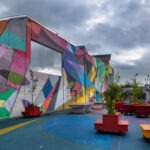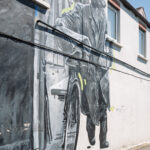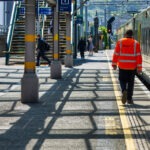3 JULY 2025
THE HIEROGLYPHS OF SUSSEX STREET [DUN LAOGHAIRE 3 JULY 2025]
The distinctive symbolic artwork seen on several walls is the work of Signs of Power, the professional name for the Dublin-based artist Vanessa Power. She was one of the official artists commissioned for the 2021 Dún Laoghaire Anseo festival. The description of her work as “hieroglyphic” is an insightful observation of its visual effect. Power is a lettering artist and sign painter who merges the traditional craft with a modern, pop-art aesthetic. The symbols are not derived from ancient scripts but are part of a unique, stylised alphabet she has developed.
This approach echoes how early 20th-century artists like Ernst Ludwig Kirchner used the term “hieroglyphs” to describe their method of translating lived experience into condensed, abstract, and symbolic visual forms. Power’s symbols, arranged in a grid and punctuated by red drips or arrows, create a powerful visual language that is meant to be experienced rather than literally read. Her work explores the power of signs and symbols in urban communication, a core theme in street art globally.
![THE HIEROGLYPHS OF SUSSEX STREET [DUN LAOGHAIRE 3 JULY 2025]-253438-1](https://excellentstreetimages.com/HeadlessUrbanExpression/wp-content/uploads/2025/07/THE-HIEROGLYPHS-OF-SUSSEX-STREET-DUN-LAOGHAIRE-3-JULY-2025-253438-1-150x150.jpg)
![THE HIEROGLYPHS OF SUSSEX STREET [DUN LAOGHAIRE 3 JULY 2025]-253439-1 THE HIEROGLYPHS OF SUSSEX STREET [DUN LAOGHAIRE 3 JULY 2025]-253439-1](https://excellentstreetimages.com/HeadlessUrbanExpression/wp-content/uploads/2025/07/THE-HIEROGLYPHS-OF-SUSSEX-STREET-DUN-LAOGHAIRE-3-JULY-2025-253439-1-1422x1067.jpg)
![THE HIEROGLYPHS OF SUSSEX STREET [DUN LAOGHAIRE 3 JULY 2025]-253438-1 THE HIEROGLYPHS OF SUSSEX STREET [DUN LAOGHAIRE 3 JULY 2025]-253438-1](https://excellentstreetimages.com/HeadlessUrbanExpression/wp-content/uploads/2025/07/THE-HIEROGLYPHS-OF-SUSSEX-STREET-DUN-LAOGHAIRE-3-JULY-2025-253438-1-1422x1067.jpg)
![THE HIEROGLYPHS OF SUSSEX STREET [DUN LAOGHAIRE 3 JULY 2025]-253437-1 THE HIEROGLYPHS OF SUSSEX STREET [DUN LAOGHAIRE 3 JULY 2025]-253437-1](https://excellentstreetimages.com/HeadlessUrbanExpression/wp-content/uploads/2025/07/THE-HIEROGLYPHS-OF-SUSSEX-STREET-DUN-LAOGHAIRE-3-JULY-2025-253437-1-1422x1067.jpg)
![THE HIEROGLYPHS OF SUSSEX STREET [DUN LAOGHAIRE 3 JULY 2025]-253436-1 THE HIEROGLYPHS OF SUSSEX STREET [DUN LAOGHAIRE 3 JULY 2025]-253436-1](https://excellentstreetimages.com/HeadlessUrbanExpression/wp-content/uploads/2025/07/THE-HIEROGLYPHS-OF-SUSSEX-STREET-DUN-LAOGHAIRE-3-JULY-2025-253436-1-1422x1067.jpg)
![THE HIEROGLYPHS OF SUSSEX STREET [DUN LAOGHAIRE 3 JULY 2025]-253435-1 THE HIEROGLYPHS OF SUSSEX STREET [DUN LAOGHAIRE 3 JULY 2025]-253435-1](https://excellentstreetimages.com/HeadlessUrbanExpression/wp-content/uploads/2025/07/THE-HIEROGLYPHS-OF-SUSSEX-STREET-DUN-LAOGHAIRE-3-JULY-2025-253435-1-1422x1067.jpg)
![THE HIEROGLYPHS OF SUSSEX STREET [DUN LAOGHAIRE 3 JULY 2025]-253434-1 THE HIEROGLYPHS OF SUSSEX STREET [DUN LAOGHAIRE 3 JULY 2025]-253434-1](https://excellentstreetimages.com/HeadlessUrbanExpression/wp-content/uploads/2025/07/THE-HIEROGLYPHS-OF-SUSSEX-STREET-DUN-LAOGHAIRE-3-JULY-2025-253434-1-1422x1067.jpg)
![A GLIMPSE INTO THOMONDGATE'S PAST [A BLACK AND WHITE MURAL]-254073-1](https://excellentstreetimages.com/HeadlessUrbanExpression/wp-content/uploads/2025/07/A-GLIMPSE-INTO-THOMONDGATES-PAST-A-BLACK-AND-WHITE-MURAL-254073-1-150x150.jpg)
![A GLIMPSE INTO THOMONDGATE'S PAST [A BLACK AND WHITE MURAL]-254074-1 A GLIMPSE INTO THOMONDGATE'S PAST [A BLACK AND WHITE MURAL]-254074-1](https://excellentstreetimages.com/HeadlessUrbanExpression/wp-content/uploads/2025/07/A-GLIMPSE-INTO-THOMONDGATES-PAST-A-BLACK-AND-WHITE-MURAL-254074-1-1422x1067.jpg)
![A GLIMPSE INTO THOMONDGATE'S PAST [A BLACK AND WHITE MURAL]-254073-1 A GLIMPSE INTO THOMONDGATE'S PAST [A BLACK AND WHITE MURAL]-254073-1](https://excellentstreetimages.com/HeadlessUrbanExpression/wp-content/uploads/2025/07/A-GLIMPSE-INTO-THOMONDGATES-PAST-A-BLACK-AND-WHITE-MURAL-254073-1-1422x1067.jpg)
![A GLIMPSE INTO THOMONDGATE'S PAST [A BLACK AND WHITE MURAL]-254072-1 A GLIMPSE INTO THOMONDGATE'S PAST [A BLACK AND WHITE MURAL]-254072-1](https://excellentstreetimages.com/HeadlessUrbanExpression/wp-content/uploads/2025/07/A-GLIMPSE-INTO-THOMONDGATES-PAST-A-BLACK-AND-WHITE-MURAL-254072-1-1422x1067.jpg)
![A GLIMPSE INTO THOMONDGATE'S PAST [A BLACK AND WHITE MURAL]-254071-1 A GLIMPSE INTO THOMONDGATE'S PAST [A BLACK AND WHITE MURAL]-254071-1](https://excellentstreetimages.com/HeadlessUrbanExpression/wp-content/uploads/2025/07/A-GLIMPSE-INTO-THOMONDGATES-PAST-A-BLACK-AND-WHITE-MURAL-254071-1-1422x1067.jpg)
![A GLIMPSE INTO THOMONDGATE'S PAST [A BLACK AND WHITE MURAL]-254070-1 A GLIMPSE INTO THOMONDGATE'S PAST [A BLACK AND WHITE MURAL]-254070-1](https://excellentstreetimages.com/HeadlessUrbanExpression/wp-content/uploads/2025/07/A-GLIMPSE-INTO-THOMONDGATES-PAST-A-BLACK-AND-WHITE-MURAL-254070-1-1422x1067.jpg)
![A GLIMPSE INTO THOMONDGATE'S PAST [A BLACK AND WHITE MURAL]-254069-1 A GLIMPSE INTO THOMONDGATE'S PAST [A BLACK AND WHITE MURAL]-254069-1](https://excellentstreetimages.com/HeadlessUrbanExpression/wp-content/uploads/2025/07/A-GLIMPSE-INTO-THOMONDGATES-PAST-A-BLACK-AND-WHITE-MURAL-254069-1-1422x1067.jpg)
![A GLIMPSE INTO THOMONDGATE'S PAST [A BLACK AND WHITE MURAL]-254067-1 A GLIMPSE INTO THOMONDGATE'S PAST [A BLACK AND WHITE MURAL]-254067-1](https://excellentstreetimages.com/HeadlessUrbanExpression/wp-content/uploads/2025/07/A-GLIMPSE-INTO-THOMONDGATES-PAST-A-BLACK-AND-WHITE-MURAL-254067-1-1422x1067.jpg)
![A GLIMPSE INTO THOMONDGATE'S PAST [A BLACK AND WHITE MURAL]-254068-1 A GLIMPSE INTO THOMONDGATE'S PAST [A BLACK AND WHITE MURAL]-254068-1](https://excellentstreetimages.com/HeadlessUrbanExpression/wp-content/uploads/2025/07/A-GLIMPSE-INTO-THOMONDGATES-PAST-A-BLACK-AND-WHITE-MURAL-254068-1-1422x1067.jpg)

![HONAN'S QUAY A CANVAS OF CONTRADICTIONS [CLOSE UP AND FAR AWAY]-254302-1](https://excellentstreetimages.com/HeadlessUrbanExpression/wp-content/uploads/2025/07/HONANS-QUAY-A-CANVAS-OF-CONTRADICTIONS-CLOSE-UP-AND-FAR-AWAY-254302-1-1422x1067.jpg)
![HONAN'S QUAY A CANVAS OF CONTRADICTIONS [CLOSE UP AND FAR AWAY]-254301-1](https://excellentstreetimages.com/HeadlessUrbanExpression/wp-content/uploads/2025/07/HONANS-QUAY-A-CANVAS-OF-CONTRADICTIONS-CLOSE-UP-AND-FAR-AWAY-254301-1-1422x1067.jpg)
![HONAN'S QUAY A CANVAS OF CONTRADICTIONS [CLOSE UP AND FAR AWAY]-254300-1](https://excellentstreetimages.com/HeadlessUrbanExpression/wp-content/uploads/2025/07/HONANS-QUAY-A-CANVAS-OF-CONTRADICTIONS-CLOSE-UP-AND-FAR-AWAY-254300-1-1422x1067.jpg)
![HONAN'S QUAY A CANVAS OF CONTRADICTIONS [CLOSE UP AND FAR AWAY]-254299-1](https://excellentstreetimages.com/HeadlessUrbanExpression/wp-content/uploads/2025/07/HONANS-QUAY-A-CANVAS-OF-CONTRADICTIONS-CLOSE-UP-AND-FAR-AWAY-254299-1-1422x1067.jpg)
![HONAN'S QUAY A CANVAS OF CONTRADICTIONS [CLOSE UP AND FAR AWAY]-254298-1](https://excellentstreetimages.com/HeadlessUrbanExpression/wp-content/uploads/2025/07/HONANS-QUAY-A-CANVAS-OF-CONTRADICTIONS-CLOSE-UP-AND-FAR-AWAY-254298-1-1422x1067.jpg)
![HONAN'S QUAY A CANVAS OF CONTRADICTIONS [CLOSE UP AND FAR AWAY]-254297-1](https://excellentstreetimages.com/HeadlessUrbanExpression/wp-content/uploads/2025/07/HONANS-QUAY-A-CANVAS-OF-CONTRADICTIONS-CLOSE-UP-AND-FAR-AWAY-254297-1-1422x1067.jpg)
![HONAN'S QUAY A CANVAS OF CONTRADICTIONS [CLOSE UP AND FAR AWAY]-254296-1](https://excellentstreetimages.com/HeadlessUrbanExpression/wp-content/uploads/2025/07/HONANS-QUAY-A-CANVAS-OF-CONTRADICTIONS-CLOSE-UP-AND-FAR-AWAY-254296-1-1422x1067.jpg)
![HONAN'S QUAY A CANVAS OF CONTRADICTIONS [CLOSE UP AND FAR AWAY]-254295-1](https://excellentstreetimages.com/HeadlessUrbanExpression/wp-content/uploads/2025/07/HONANS-QUAY-A-CANVAS-OF-CONTRADICTIONS-CLOSE-UP-AND-FAR-AWAY-254295-1-1422x1067.jpg)
![HONAN'S QUAY A CANVAS OF CONTRADICTIONS [CLOSE UP AND FAR AWAY]-254294-1](https://excellentstreetimages.com/HeadlessUrbanExpression/wp-content/uploads/2025/07/HONANS-QUAY-A-CANVAS-OF-CONTRADICTIONS-CLOSE-UP-AND-FAR-AWAY-254294-1-1422x1067.jpg)
![HONAN'S QUAY A CANVAS OF CONTRADICTIONS [CLOSE UP AND FAR AWAY]-254293-1](https://excellentstreetimages.com/HeadlessUrbanExpression/wp-content/uploads/2025/07/HONANS-QUAY-A-CANVAS-OF-CONTRADICTIONS-CLOSE-UP-AND-FAR-AWAY-254293-1-1422x1067.jpg)
![HONAN'S QUAY A CANVAS OF CONTRADICTIONS [CLOSE UP AND FAR AWAY]-254292-1](https://excellentstreetimages.com/HeadlessUrbanExpression/wp-content/uploads/2025/07/HONANS-QUAY-A-CANVAS-OF-CONTRADICTIONS-CLOSE-UP-AND-FAR-AWAY-254292-1-1422x1067.jpg)
![HONAN'S QUAY A CANVAS OF CONTRADICTIONS [CLOSE UP AND FAR AWAY]-254291-1](https://excellentstreetimages.com/HeadlessUrbanExpression/wp-content/uploads/2025/07/HONANS-QUAY-A-CANVAS-OF-CONTRADICTIONS-CLOSE-UP-AND-FAR-AWAY-254291-1-1422x1067.jpg)
![HONAN'S QUAY A CANVAS OF CONTRADICTIONS [CLOSE UP AND FAR AWAY]-254289-1](https://excellentstreetimages.com/HeadlessUrbanExpression/wp-content/uploads/2025/07/HONANS-QUAY-A-CANVAS-OF-CONTRADICTIONS-CLOSE-UP-AND-FAR-AWAY-254289-1-1422x1067.jpg)
![HONAN'S QUAY A CANVAS OF CONTRADICTIONS [CLOSE UP AND FAR AWAY]-254290-1](https://excellentstreetimages.com/HeadlessUrbanExpression/wp-content/uploads/2025/07/HONANS-QUAY-A-CANVAS-OF-CONTRADICTIONS-CLOSE-UP-AND-FAR-AWAY-254290-1-1422x1067.jpg)
![HONAN'S QUAY A CANVAS OF CONTRADICTIONS [CLOSE UP AND FAR AWAY]-254288-1](https://excellentstreetimages.com/HeadlessUrbanExpression/wp-content/uploads/2025/07/HONANS-QUAY-A-CANVAS-OF-CONTRADICTIONS-CLOSE-UP-AND-FAR-AWAY-254288-1-1422x1067.jpg)
![HONAN'S QUAY A CANVAS OF CONTRADICTIONS [CLOSE UP AND FAR AWAY]-254287-1](https://excellentstreetimages.com/HeadlessUrbanExpression/wp-content/uploads/2025/07/HONANS-QUAY-A-CANVAS-OF-CONTRADICTIONS-CLOSE-UP-AND-FAR-AWAY-254287-1-1422x1067.jpg)
![HONAN'S QUAY A CANVAS OF CONTRADICTIONS [CLOSE UP AND FAR AWAY]-254286-1](https://excellentstreetimages.com/HeadlessUrbanExpression/wp-content/uploads/2025/07/HONANS-QUAY-A-CANVAS-OF-CONTRADICTIONS-CLOSE-UP-AND-FAR-AWAY-254286-1.jpg)
![HONAN'S QUAY A CANVAS OF CONTRADICTIONS [CLOSE UP AND FAR AWAY]-254285-1](https://excellentstreetimages.com/HeadlessUrbanExpression/wp-content/uploads/2025/07/HONANS-QUAY-A-CANVAS-OF-CONTRADICTIONS-CLOSE-UP-AND-FAR-AWAY-254285-1.jpg)
![HONAN'S QUAY A CANVAS OF CONTRADICTIONS [CLOSE UP AND FAR AWAY]-254284-1](https://excellentstreetimages.com/HeadlessUrbanExpression/wp-content/uploads/2025/07/HONANS-QUAY-A-CANVAS-OF-CONTRADICTIONS-CLOSE-UP-AND-FAR-AWAY-254284-1.jpg)
![HONAN'S QUAY A CANVAS OF CONTRADICTIONS [CLOSE UP AND FAR AWAY]-254283-1](https://excellentstreetimages.com/HeadlessUrbanExpression/wp-content/uploads/2025/07/HONANS-QUAY-A-CANVAS-OF-CONTRADICTIONS-CLOSE-UP-AND-FAR-AWAY-254283-1-1186x890.jpg)
![HONAN'S QUAY A CANVAS OF CONTRADICTIONS [CLOSE UP AND FAR AWAY]-254282-1](https://excellentstreetimages.com/HeadlessUrbanExpression/wp-content/uploads/2025/07/HONANS-QUAY-A-CANVAS-OF-CONTRADICTIONS-CLOSE-UP-AND-FAR-AWAY-254282-1-1422x1067.jpg)
![HONAN'S QUAY A CANVAS OF CONTRADICTIONS [CLOSE UP AND FAR AWAY]-254281-1](https://excellentstreetimages.com/HeadlessUrbanExpression/wp-content/uploads/2025/07/HONANS-QUAY-A-CANVAS-OF-CONTRADICTIONS-CLOSE-UP-AND-FAR-AWAY-254281-1-1422x1067.jpg)
![HONAN'S QUAY A CANVAS OF CONTRADICTIONS [CLOSE UP AND FAR AWAY]-254280-1](https://excellentstreetimages.com/HeadlessUrbanExpression/wp-content/uploads/2025/07/HONANS-QUAY-A-CANVAS-OF-CONTRADICTIONS-CLOSE-UP-AND-FAR-AWAY-254280-1-1422x1067.jpg)
![HONAN'S QUAY A CANVAS OF CONTRADICTIONS [CLOSE UP AND FAR AWAY]-254279-1](https://excellentstreetimages.com/HeadlessUrbanExpression/wp-content/uploads/2025/07/HONANS-QUAY-A-CANVAS-OF-CONTRADICTIONS-CLOSE-UP-AND-FAR-AWAY-254279-1-1422x1067.jpg)
![HONAN'S QUAY A CANVAS OF CONTRADICTIONS [CLOSE UP AND FAR AWAY]-254278-1](https://excellentstreetimages.com/HeadlessUrbanExpression/wp-content/uploads/2025/07/HONANS-QUAY-A-CANVAS-OF-CONTRADICTIONS-CLOSE-UP-AND-FAR-AWAY-254278-1-1422x1067.jpg)
![HONAN'S QUAY A CANVAS OF CONTRADICTIONS [CLOSE UP AND FAR AWAY]-254277-1](https://excellentstreetimages.com/HeadlessUrbanExpression/wp-content/uploads/2025/07/HONANS-QUAY-A-CANVAS-OF-CONTRADICTIONS-CLOSE-UP-AND-FAR-AWAY-254277-1-1422x1067.jpg)
![HONAN'S QUAY A CANVAS OF CONTRADICTIONS [CLOSE UP AND FAR AWAY]-254276-1](https://excellentstreetimages.com/HeadlessUrbanExpression/wp-content/uploads/2025/07/HONANS-QUAY-A-CANVAS-OF-CONTRADICTIONS-CLOSE-UP-AND-FAR-AWAY-254276-1-1438x1079.jpg)
![HONAN'S QUAY A CANVAS OF CONTRADICTIONS [CLOSE UP AND FAR AWAY]-254275-1](https://excellentstreetimages.com/HeadlessUrbanExpression/wp-content/uploads/2025/07/HONANS-QUAY-A-CANVAS-OF-CONTRADICTIONS-CLOSE-UP-AND-FAR-AWAY-254275-1.jpg)
![HONAN'S QUAY A CANVAS OF CONTRADICTIONS [CLOSE UP AND FAR AWAY]-254274-1](https://excellentstreetimages.com/HeadlessUrbanExpression/wp-content/uploads/2025/07/HONANS-QUAY-A-CANVAS-OF-CONTRADICTIONS-CLOSE-UP-AND-FAR-AWAY-254274-1.jpg)
![HONAN'S QUAY A CANVAS OF CONTRADICTIONS [CLOSE UP AND FAR AWAY]-254273-1](https://excellentstreetimages.com/HeadlessUrbanExpression/wp-content/uploads/2025/07/HONANS-QUAY-A-CANVAS-OF-CONTRADICTIONS-CLOSE-UP-AND-FAR-AWAY-254273-1.jpg)
![HONAN'S QUAY A CANVAS OF CONTRADICTIONS [CLOSE UP AND FAR AWAY]-254272-1](https://excellentstreetimages.com/HeadlessUrbanExpression/wp-content/uploads/2025/07/HONANS-QUAY-A-CANVAS-OF-CONTRADICTIONS-CLOSE-UP-AND-FAR-AWAY-254272-1.jpg)
![HONAN'S QUAY A CANVAS OF CONTRADICTIONS [CLOSE UP AND FAR AWAY]-254271-1](https://excellentstreetimages.com/HeadlessUrbanExpression/wp-content/uploads/2025/07/HONANS-QUAY-A-CANVAS-OF-CONTRADICTIONS-CLOSE-UP-AND-FAR-AWAY-254271-1.jpg)
![HONAN'S QUAY A CANVAS OF CONTRADICTIONS [CLOSE UP AND FAR AWAY]-254270-1](https://excellentstreetimages.com/HeadlessUrbanExpression/wp-content/uploads/2025/07/HONANS-QUAY-A-CANVAS-OF-CONTRADICTIONS-CLOSE-UP-AND-FAR-AWAY-254270-1.jpg)
![HONAN'S QUAY A CANVAS OF CONTRADICTIONS [CLOSE UP AND FAR AWAY]-254269-1](https://excellentstreetimages.com/HeadlessUrbanExpression/wp-content/uploads/2025/07/HONANS-QUAY-A-CANVAS-OF-CONTRADICTIONS-CLOSE-UP-AND-FAR-AWAY-254269-1.jpg)
![HONAN'S QUAY A CANVAS OF CONTRADICTIONS [CLOSE UP AND FAR AWAY]-254268-1](https://excellentstreetimages.com/HeadlessUrbanExpression/wp-content/uploads/2025/07/HONANS-QUAY-A-CANVAS-OF-CONTRADICTIONS-CLOSE-UP-AND-FAR-AWAY-254268-1.jpg)
![HONAN'S QUAY A CANVAS OF CONTRADICTIONS [CLOSE UP AND FAR AWAY]-254267-1](https://excellentstreetimages.com/HeadlessUrbanExpression/wp-content/uploads/2025/07/HONANS-QUAY-A-CANVAS-OF-CONTRADICTIONS-CLOSE-UP-AND-FAR-AWAY-254267-1.jpg)

![EXAMPLES OF STREET ART IN DUNDALK [I HAD TO ABANDON THIS SESSION BUT WILL RETURN AT A LATER DATE]-251432-1](https://excellentstreetimages.com/HeadlessUrbanExpression/wp-content/uploads/2025/05/EXAMPLES-OF-STREET-ART-IN-DUNDALK-I-HAD-TO-ABANDON-THIS-SESSION-BUT-WILL-RETURN-AT-A-LATER-DATE-251432-1-1420x1065.jpg)
![EXAMPLES OF STREET ART IN DUNDALK [I HAD TO ABANDON THIS SESSION BUT WILL RETURN AT A LATER DATE]-251433-1](https://excellentstreetimages.com/HeadlessUrbanExpression/wp-content/uploads/2025/05/EXAMPLES-OF-STREET-ART-IN-DUNDALK-I-HAD-TO-ABANDON-THIS-SESSION-BUT-WILL-RETURN-AT-A-LATER-DATE-251433-1-1420x1065.jpg)
![EXAMPLES OF STREET ART IN DUNDALK [I HAD TO ABANDON THIS SESSION BUT WILL RETURN AT A LATER DATE]-251431-1](https://excellentstreetimages.com/HeadlessUrbanExpression/wp-content/uploads/2025/05/EXAMPLES-OF-STREET-ART-IN-DUNDALK-I-HAD-TO-ABANDON-THIS-SESSION-BUT-WILL-RETURN-AT-A-LATER-DATE-251431-1-1420x1065.jpg)
![EXAMPLES OF STREET ART IN DUNDALK [I HAD TO ABANDON THIS SESSION BUT WILL RETURN AT A LATER DATE]-251430-1](https://excellentstreetimages.com/HeadlessUrbanExpression/wp-content/uploads/2025/05/EXAMPLES-OF-STREET-ART-IN-DUNDALK-I-HAD-TO-ABANDON-THIS-SESSION-BUT-WILL-RETURN-AT-A-LATER-DATE-251430-1-1420x1065.jpg)
![EXAMPLES OF STREET ART IN DUNDALK [I HAD TO ABANDON THIS SESSION BUT WILL RETURN AT A LATER DATE]-251428-1](https://excellentstreetimages.com/HeadlessUrbanExpression/wp-content/uploads/2025/05/EXAMPLES-OF-STREET-ART-IN-DUNDALK-I-HAD-TO-ABANDON-THIS-SESSION-BUT-WILL-RETURN-AT-A-LATER-DATE-251428-1-1420x1065.jpg)
![EXAMPLES OF STREET ART IN DUNDALK [I HAD TO ABANDON THIS SESSION BUT WILL RETURN AT A LATER DATE]-251429-1](https://excellentstreetimages.com/HeadlessUrbanExpression/wp-content/uploads/2025/05/EXAMPLES-OF-STREET-ART-IN-DUNDALK-I-HAD-TO-ABANDON-THIS-SESSION-BUT-WILL-RETURN-AT-A-LATER-DATE-251429-1-1420x1065.jpg)
![EXAMPLES OF STREET ART IN DUNDALK [I HAD TO ABANDON THIS SESSION BUT WILL RETURN AT A LATER DATE]-251427-1](https://excellentstreetimages.com/HeadlessUrbanExpression/wp-content/uploads/2025/05/EXAMPLES-OF-STREET-ART-IN-DUNDALK-I-HAD-TO-ABANDON-THIS-SESSION-BUT-WILL-RETURN-AT-A-LATER-DATE-251427-1-1420x1065.jpg)
![EXAMPLES OF STREET ART IN DUNDALK [I HAD TO ABANDON THIS SESSION BUT WILL RETURN AT A LATER DATE]-251426-1](https://excellentstreetimages.com/HeadlessUrbanExpression/wp-content/uploads/2025/05/EXAMPLES-OF-STREET-ART-IN-DUNDALK-I-HAD-TO-ABANDON-THIS-SESSION-BUT-WILL-RETURN-AT-A-LATER-DATE-251426-1-1420x1065.jpg)
![EXAMPLES OF STREET ART IN DUNDALK [I HAD TO ABANDON THIS SESSION BUT WILL RETURN AT A LATER DATE]-251424-1](https://excellentstreetimages.com/HeadlessUrbanExpression/wp-content/uploads/2025/05/EXAMPLES-OF-STREET-ART-IN-DUNDALK-I-HAD-TO-ABANDON-THIS-SESSION-BUT-WILL-RETURN-AT-A-LATER-DATE-251424-1-1420x1065.jpg)
![EXAMPLES OF STREET ART IN DUNDALK [I HAD TO ABANDON THIS SESSION BUT WILL RETURN AT A LATER DATE]-251425-1](https://excellentstreetimages.com/HeadlessUrbanExpression/wp-content/uploads/2025/05/EXAMPLES-OF-STREET-ART-IN-DUNDALK-I-HAD-TO-ABANDON-THIS-SESSION-BUT-WILL-RETURN-AT-A-LATER-DATE-251425-1-1420x1065.jpg)
![EXAMPLES OF STREET ART IN DUNDALK [I HAD TO ABANDON THIS SESSION BUT WILL RETURN AT A LATER DATE]-251423-1](https://excellentstreetimages.com/HeadlessUrbanExpression/wp-content/uploads/2025/05/EXAMPLES-OF-STREET-ART-IN-DUNDALK-I-HAD-TO-ABANDON-THIS-SESSION-BUT-WILL-RETURN-AT-A-LATER-DATE-251423-1-1420x1065.jpg)
![EXAMPLES OF STREET ART IN DUNDALK [I HAD TO ABANDON THIS SESSION BUT WILL RETURN AT A LATER DATE]-251422-1](https://excellentstreetimages.com/HeadlessUrbanExpression/wp-content/uploads/2025/05/EXAMPLES-OF-STREET-ART-IN-DUNDALK-I-HAD-TO-ABANDON-THIS-SESSION-BUT-WILL-RETURN-AT-A-LATER-DATE-251422-1-1420x1065.jpg)
![EXAMPLES OF STREET ART IN DUNDALK [I HAD TO ABANDON THIS SESSION BUT WILL RETURN AT A LATER DATE]-251421-1](https://excellentstreetimages.com/HeadlessUrbanExpression/wp-content/uploads/2025/05/EXAMPLES-OF-STREET-ART-IN-DUNDALK-I-HAD-TO-ABANDON-THIS-SESSION-BUT-WILL-RETURN-AT-A-LATER-DATE-251421-1-1420x1065.jpg)
![EXAMPLES OF STREET ART IN DUNDALK [I HAD TO ABANDON THIS SESSION BUT WILL RETURN AT A LATER DATE]-251419-1](https://excellentstreetimages.com/HeadlessUrbanExpression/wp-content/uploads/2025/05/EXAMPLES-OF-STREET-ART-IN-DUNDALK-I-HAD-TO-ABANDON-THIS-SESSION-BUT-WILL-RETURN-AT-A-LATER-DATE-251419-1-1420x1065.jpg)
![EXAMPLES OF STREET ART IN DUNDALK [I HAD TO ABANDON THIS SESSION BUT WILL RETURN AT A LATER DATE]-251420-1](https://excellentstreetimages.com/HeadlessUrbanExpression/wp-content/uploads/2025/05/EXAMPLES-OF-STREET-ART-IN-DUNDALK-I-HAD-TO-ABANDON-THIS-SESSION-BUT-WILL-RETURN-AT-A-LATER-DATE-251420-1-1420x1065.jpg)
![EXAMPLES OF STREET ART IN DUNDALK [I HAD TO ABANDON THIS SESSION BUT WILL RETURN AT A LATER DATE]-251418-1](https://excellentstreetimages.com/HeadlessUrbanExpression/wp-content/uploads/2025/05/EXAMPLES-OF-STREET-ART-IN-DUNDALK-I-HAD-TO-ABANDON-THIS-SESSION-BUT-WILL-RETURN-AT-A-LATER-DATE-251418-1-1420x1065.jpg)
![EXAMPLES OF STREET ART IN DUNDALK [I HAD TO ABANDON THIS SESSION BUT WILL RETURN AT A LATER DATE]-251416-1](https://excellentstreetimages.com/HeadlessUrbanExpression/wp-content/uploads/2025/05/EXAMPLES-OF-STREET-ART-IN-DUNDALK-I-HAD-TO-ABANDON-THIS-SESSION-BUT-WILL-RETURN-AT-A-LATER-DATE-251416-1-1420x1065.jpg)
![EXAMPLES OF STREET ART IN DUNDALK [I HAD TO ABANDON THIS SESSION BUT WILL RETURN AT A LATER DATE]-251417-1](https://excellentstreetimages.com/HeadlessUrbanExpression/wp-content/uploads/2025/05/EXAMPLES-OF-STREET-ART-IN-DUNDALK-I-HAD-TO-ABANDON-THIS-SESSION-BUT-WILL-RETURN-AT-A-LATER-DATE-251417-1-1420x1065.jpg)
![EXAMPLES OF STREET ART IN DUNDALK [I HAD TO ABANDON THIS SESSION BUT WILL RETURN AT A LATER DATE]-251415-1](https://excellentstreetimages.com/HeadlessUrbanExpression/wp-content/uploads/2025/05/EXAMPLES-OF-STREET-ART-IN-DUNDALK-I-HAD-TO-ABANDON-THIS-SESSION-BUT-WILL-RETURN-AT-A-LATER-DATE-251415-1-1420x1065.jpg)
![EXAMPLES OF STREET ART IN DUNDALK [I HAD TO ABANDON THIS SESSION BUT WILL RETURN AT A LATER DATE]-251413-1](https://excellentstreetimages.com/HeadlessUrbanExpression/wp-content/uploads/2025/05/EXAMPLES-OF-STREET-ART-IN-DUNDALK-I-HAD-TO-ABANDON-THIS-SESSION-BUT-WILL-RETURN-AT-A-LATER-DATE-251413-1-1420x1065.jpg)
![EXAMPLES OF STREET ART IN DUNDALK [I HAD TO ABANDON THIS SESSION BUT WILL RETURN AT A LATER DATE]-251414-1](https://excellentstreetimages.com/HeadlessUrbanExpression/wp-content/uploads/2025/05/EXAMPLES-OF-STREET-ART-IN-DUNDALK-I-HAD-TO-ABANDON-THIS-SESSION-BUT-WILL-RETURN-AT-A-LATER-DATE-251414-1-1420x1065.jpg)
![EXAMPLES OF STREET ART IN DUNDALK [I HAD TO ABANDON THIS SESSION BUT WILL RETURN AT A LATER DATE]-251412-1](https://excellentstreetimages.com/HeadlessUrbanExpression/wp-content/uploads/2025/05/EXAMPLES-OF-STREET-ART-IN-DUNDALK-I-HAD-TO-ABANDON-THIS-SESSION-BUT-WILL-RETURN-AT-A-LATER-DATE-251412-1-1420x1065.jpg)
![EXAMPLES OF STREET ART IN DUNDALK [I HAD TO ABANDON THIS SESSION BUT WILL RETURN AT A LATER DATE]-251411-1](https://excellentstreetimages.com/HeadlessUrbanExpression/wp-content/uploads/2025/05/EXAMPLES-OF-STREET-ART-IN-DUNDALK-I-HAD-TO-ABANDON-THIS-SESSION-BUT-WILL-RETURN-AT-A-LATER-DATE-251411-1-1420x1065.jpg)
![EXAMPLES OF STREET ART IN DUNDALK [I HAD TO ABANDON THIS SESSION BUT WILL RETURN AT A LATER DATE]-251410-1](https://excellentstreetimages.com/HeadlessUrbanExpression/wp-content/uploads/2025/05/EXAMPLES-OF-STREET-ART-IN-DUNDALK-I-HAD-TO-ABANDON-THIS-SESSION-BUT-WILL-RETURN-AT-A-LATER-DATE-251410-1-1420x1065.jpg)
![EXAMPLES OF STREET ART IN DUNDALK [I HAD TO ABANDON THIS SESSION BUT WILL RETURN AT A LATER DATE]-251409-1](https://excellentstreetimages.com/HeadlessUrbanExpression/wp-content/uploads/2025/05/EXAMPLES-OF-STREET-ART-IN-DUNDALK-I-HAD-TO-ABANDON-THIS-SESSION-BUT-WILL-RETURN-AT-A-LATER-DATE-251409-1-1420x1065.jpg)
![EXAMPLES OF STREET ART IN DUNDALK [I HAD TO ABANDON THIS SESSION BUT WILL RETURN AT A LATER DATE]-251408-1](https://excellentstreetimages.com/HeadlessUrbanExpression/wp-content/uploads/2025/05/EXAMPLES-OF-STREET-ART-IN-DUNDALK-I-HAD-TO-ABANDON-THIS-SESSION-BUT-WILL-RETURN-AT-A-LATER-DATE-251408-1-1420x1065.jpg)
![EXAMPLES OF STREET ART IN DUNDALK [I HAD TO ABANDON THIS SESSION BUT WILL RETURN AT A LATER DATE]-251407-1](https://excellentstreetimages.com/HeadlessUrbanExpression/wp-content/uploads/2025/05/EXAMPLES-OF-STREET-ART-IN-DUNDALK-I-HAD-TO-ABANDON-THIS-SESSION-BUT-WILL-RETURN-AT-A-LATER-DATE-251407-1-1420x1065.jpg)
![EXAMPLES OF STREET ART IN DUNDALK [I HAD TO ABANDON THIS SESSION BUT WILL RETURN AT A LATER DATE]-251406-1](https://excellentstreetimages.com/HeadlessUrbanExpression/wp-content/uploads/2025/05/EXAMPLES-OF-STREET-ART-IN-DUNDALK-I-HAD-TO-ABANDON-THIS-SESSION-BUT-WILL-RETURN-AT-A-LATER-DATE-251406-1-1420x1065.jpg)
![EXAMPLES OF STREET ART IN DUNDALK [I HAD TO ABANDON THIS SESSION BUT WILL RETURN AT A LATER DATE]-251405-1](https://excellentstreetimages.com/HeadlessUrbanExpression/wp-content/uploads/2025/05/EXAMPLES-OF-STREET-ART-IN-DUNDALK-I-HAD-TO-ABANDON-THIS-SESSION-BUT-WILL-RETURN-AT-A-LATER-DATE-251405-1-1420x1065.jpg)
![EXAMPLES OF STREET ART IN DUNDALK [I HAD TO ABANDON THIS SESSION BUT WILL RETURN AT A LATER DATE]-251403-1](https://excellentstreetimages.com/HeadlessUrbanExpression/wp-content/uploads/2025/05/EXAMPLES-OF-STREET-ART-IN-DUNDALK-I-HAD-TO-ABANDON-THIS-SESSION-BUT-WILL-RETURN-AT-A-LATER-DATE-251403-1-1420x1065.jpg)
![EXAMPLES OF STREET ART IN DUNDALK [I HAD TO ABANDON THIS SESSION BUT WILL RETURN AT A LATER DATE]-251404-1](https://excellentstreetimages.com/HeadlessUrbanExpression/wp-content/uploads/2025/05/EXAMPLES-OF-STREET-ART-IN-DUNDALK-I-HAD-TO-ABANDON-THIS-SESSION-BUT-WILL-RETURN-AT-A-LATER-DATE-251404-1-1420x1065.jpg)
![EXAMPLES OF STREET ART IN DUNDALK [I HAD TO ABANDON THIS SESSION BUT WILL RETURN AT A LATER DATE]-251402-1](https://excellentstreetimages.com/HeadlessUrbanExpression/wp-content/uploads/2025/05/EXAMPLES-OF-STREET-ART-IN-DUNDALK-I-HAD-TO-ABANDON-THIS-SESSION-BUT-WILL-RETURN-AT-A-LATER-DATE-251402-1-1420x1065.jpg)
![EXAMPLES OF STREET ART IN DUNDALK [I HAD TO ABANDON THIS SESSION BUT WILL RETURN AT A LATER DATE]-251401-1](https://excellentstreetimages.com/HeadlessUrbanExpression/wp-content/uploads/2025/05/EXAMPLES-OF-STREET-ART-IN-DUNDALK-I-HAD-TO-ABANDON-THIS-SESSION-BUT-WILL-RETURN-AT-A-LATER-DATE-251401-1-1420x1065.jpg)
![EXAMPLES OF STREET ART IN DUNDALK [I HAD TO ABANDON THIS SESSION BUT WILL RETURN AT A LATER DATE]-251400-1](https://excellentstreetimages.com/HeadlessUrbanExpression/wp-content/uploads/2025/05/EXAMPLES-OF-STREET-ART-IN-DUNDALK-I-HAD-TO-ABANDON-THIS-SESSION-BUT-WILL-RETURN-AT-A-LATER-DATE-251400-1-1420x1065.jpg)
![EXAMPLES OF STREET ART IN DUNDALK [I HAD TO ABANDON THIS SESSION BUT WILL RETURN AT A LATER DATE]-251399-1](https://excellentstreetimages.com/HeadlessUrbanExpression/wp-content/uploads/2025/05/EXAMPLES-OF-STREET-ART-IN-DUNDALK-I-HAD-TO-ABANDON-THIS-SESSION-BUT-WILL-RETURN-AT-A-LATER-DATE-251399-1-1420x1065.jpg)
![THE MURALS AND MOSAICS AT BRAY DALY TRAIN STATION [PHOTOGRAPHED 7 MAY 2025]-250708-1](https://excellentstreetimages.com/HeadlessUrbanExpression/wp-content/uploads/2025/05/THE-MURALS-AND-MOSAICS-AT-BRAY-DALY-TRAIN-STATION-PHOTOGRAPHED-7-MAY-2025-250708-1-150x150.jpg)
![THE MURALS AND MOSAICS AT BRAY DALY TRAIN STATION [PHOTOGRAPHED 7 MAY 2025]-250717-1 THE MURALS AND MOSAICS AT BRAY DALY TRAIN STATION [PHOTOGRAPHED 7 MAY 2025]-250717-1](https://excellentstreetimages.com/HeadlessUrbanExpression/wp-content/uploads/2025/05/THE-MURALS-AND-MOSAICS-AT-BRAY-DALY-TRAIN-STATION-PHOTOGRAPHED-7-MAY-2025-250717-1-1422x1067.jpg)
![THE MURALS AND MOSAICS AT BRAY DALY TRAIN STATION [PHOTOGRAPHED 7 MAY 2025]-250716-1 THE MURALS AND MOSAICS AT BRAY DALY TRAIN STATION [PHOTOGRAPHED 7 MAY 2025]-250716-1](https://excellentstreetimages.com/HeadlessUrbanExpression/wp-content/uploads/2025/05/THE-MURALS-AND-MOSAICS-AT-BRAY-DALY-TRAIN-STATION-PHOTOGRAPHED-7-MAY-2025-250716-1-1422x1067.jpg)
![THE MURALS AND MOSAICS AT BRAY DALY TRAIN STATION [PHOTOGRAPHED 7 MAY 2025]-250715-1 THE MURALS AND MOSAICS AT BRAY DALY TRAIN STATION [PHOTOGRAPHED 7 MAY 2025]-250715-1](https://excellentstreetimages.com/HeadlessUrbanExpression/wp-content/uploads/2025/05/THE-MURALS-AND-MOSAICS-AT-BRAY-DALY-TRAIN-STATION-PHOTOGRAPHED-7-MAY-2025-250715-1-1422x1067.jpg)
![THE MURALS AND MOSAICS AT BRAY DALY TRAIN STATION [PHOTOGRAPHED 7 MAY 2025]-250714-1 THE MURALS AND MOSAICS AT BRAY DALY TRAIN STATION [PHOTOGRAPHED 7 MAY 2025]-250714-1](https://excellentstreetimages.com/HeadlessUrbanExpression/wp-content/uploads/2025/05/THE-MURALS-AND-MOSAICS-AT-BRAY-DALY-TRAIN-STATION-PHOTOGRAPHED-7-MAY-2025-250714-1-1422x1067.jpg)
![THE MURALS AND MOSAICS AT BRAY DALY TRAIN STATION [PHOTOGRAPHED 7 MAY 2025]-250713-1 THE MURALS AND MOSAICS AT BRAY DALY TRAIN STATION [PHOTOGRAPHED 7 MAY 2025]-250713-1](https://excellentstreetimages.com/HeadlessUrbanExpression/wp-content/uploads/2025/05/THE-MURALS-AND-MOSAICS-AT-BRAY-DALY-TRAIN-STATION-PHOTOGRAPHED-7-MAY-2025-250713-1-1422x1067.jpg)
![THE MURALS AND MOSAICS AT BRAY DALY TRAIN STATION [PHOTOGRAPHED 7 MAY 2025]-250712-1 THE MURALS AND MOSAICS AT BRAY DALY TRAIN STATION [PHOTOGRAPHED 7 MAY 2025]-250712-1](https://excellentstreetimages.com/HeadlessUrbanExpression/wp-content/uploads/2025/05/THE-MURALS-AND-MOSAICS-AT-BRAY-DALY-TRAIN-STATION-PHOTOGRAPHED-7-MAY-2025-250712-1-1422x1067.jpg)
![THE MURALS AND MOSAICS AT BRAY DALY TRAIN STATION [PHOTOGRAPHED 7 MAY 2025]-250711-1 THE MURALS AND MOSAICS AT BRAY DALY TRAIN STATION [PHOTOGRAPHED 7 MAY 2025]-250711-1](https://excellentstreetimages.com/HeadlessUrbanExpression/wp-content/uploads/2025/05/THE-MURALS-AND-MOSAICS-AT-BRAY-DALY-TRAIN-STATION-PHOTOGRAPHED-7-MAY-2025-250711-1-1422x1067.jpg)
![THE MURALS AND MOSAICS AT BRAY DALY TRAIN STATION [PHOTOGRAPHED 7 MAY 2025]-250710-1 THE MURALS AND MOSAICS AT BRAY DALY TRAIN STATION [PHOTOGRAPHED 7 MAY 2025]-250710-1](https://excellentstreetimages.com/HeadlessUrbanExpression/wp-content/uploads/2025/05/THE-MURALS-AND-MOSAICS-AT-BRAY-DALY-TRAIN-STATION-PHOTOGRAPHED-7-MAY-2025-250710-1-1422x1067.jpg)
![THE MURALS AND MOSAICS AT BRAY DALY TRAIN STATION [PHOTOGRAPHED 7 MAY 2025]-250709-1 THE MURALS AND MOSAICS AT BRAY DALY TRAIN STATION [PHOTOGRAPHED 7 MAY 2025]-250709-1](https://excellentstreetimages.com/HeadlessUrbanExpression/wp-content/uploads/2025/05/THE-MURALS-AND-MOSAICS-AT-BRAY-DALY-TRAIN-STATION-PHOTOGRAPHED-7-MAY-2025-250709-1-1422x1067.jpg)
![THE MURALS AND MOSAICS AT BRAY DALY TRAIN STATION [PHOTOGRAPHED 7 MAY 2025]-250708-1 THE MURALS AND MOSAICS AT BRAY DALY TRAIN STATION [PHOTOGRAPHED 7 MAY 2025]-250708-1](https://excellentstreetimages.com/HeadlessUrbanExpression/wp-content/uploads/2025/05/THE-MURALS-AND-MOSAICS-AT-BRAY-DALY-TRAIN-STATION-PHOTOGRAPHED-7-MAY-2025-250708-1-1422x1067.jpg)
![THE MURALS AND MOSAICS AT BRAY DALY TRAIN STATION [PHOTOGRAPHED 7 MAY 2025]-250707-1 THE MURALS AND MOSAICS AT BRAY DALY TRAIN STATION [PHOTOGRAPHED 7 MAY 2025]-250707-1](https://excellentstreetimages.com/HeadlessUrbanExpression/wp-content/uploads/2025/05/THE-MURALS-AND-MOSAICS-AT-BRAY-DALY-TRAIN-STATION-PHOTOGRAPHED-7-MAY-2025-250707-1-1422x1067.jpg)
![THE MURALS AND MOSAICS AT BRAY DALY TRAIN STATION [PHOTOGRAPHED 7 MAY 2025]-250706-1 THE MURALS AND MOSAICS AT BRAY DALY TRAIN STATION [PHOTOGRAPHED 7 MAY 2025]-250706-1](https://excellentstreetimages.com/HeadlessUrbanExpression/wp-content/uploads/2025/05/THE-MURALS-AND-MOSAICS-AT-BRAY-DALY-TRAIN-STATION-PHOTOGRAPHED-7-MAY-2025-250706-1-1422x1067.jpg)
![THE MURALS AND MOSAICS AT BRAY DALY TRAIN STATION [PHOTOGRAPHED 7 MAY 2025]-250705-1 THE MURALS AND MOSAICS AT BRAY DALY TRAIN STATION [PHOTOGRAPHED 7 MAY 2025]-250705-1](https://excellentstreetimages.com/HeadlessUrbanExpression/wp-content/uploads/2025/05/THE-MURALS-AND-MOSAICS-AT-BRAY-DALY-TRAIN-STATION-PHOTOGRAPHED-7-MAY-2025-250705-1-1422x1067.jpg)
![THE MURALS AND MOSAICS AT BRAY DALY TRAIN STATION [PHOTOGRAPHED 7 MAY 2025]-250703-1 THE MURALS AND MOSAICS AT BRAY DALY TRAIN STATION [PHOTOGRAPHED 7 MAY 2025]-250703-1](https://excellentstreetimages.com/HeadlessUrbanExpression/wp-content/uploads/2025/05/THE-MURALS-AND-MOSAICS-AT-BRAY-DALY-TRAIN-STATION-PHOTOGRAPHED-7-MAY-2025-250703-1-1422x1067.jpg)
![THE MURALS AND MOSAICS AT BRAY DALY TRAIN STATION [PHOTOGRAPHED 7 MAY 2025]-250704-1 THE MURALS AND MOSAICS AT BRAY DALY TRAIN STATION [PHOTOGRAPHED 7 MAY 2025]-250704-1](https://excellentstreetimages.com/HeadlessUrbanExpression/wp-content/uploads/2025/05/THE-MURALS-AND-MOSAICS-AT-BRAY-DALY-TRAIN-STATION-PHOTOGRAPHED-7-MAY-2025-250704-1-1422x1067.jpg)
![THE MURALS AND MOSAICS AT BRAY DALY TRAIN STATION [PHOTOGRAPHED 7 MAY 2025]-250702-1 THE MURALS AND MOSAICS AT BRAY DALY TRAIN STATION [PHOTOGRAPHED 7 MAY 2025]-250702-1](https://excellentstreetimages.com/HeadlessUrbanExpression/wp-content/uploads/2025/05/THE-MURALS-AND-MOSAICS-AT-BRAY-DALY-TRAIN-STATION-PHOTOGRAPHED-7-MAY-2025-250702-1-1422x1067.jpg)

![BRAY DALY STATION IN NOW A MINI TRANSPORT HUB [7 MAY 2025]-250704-1](https://excellentstreetimages.com/HeadlessUrbanExpression/wp-content/uploads/2025/05/BRAY-DALY-STATION-IN-NOW-A-MINI-TRANSPORT-HUB-7-MAY-2025-250704-1-1422x1067.jpg)
![BRAY DALY STATION IN NOW A MINI TRANSPORT HUB [7 MAY 2025]-250703-1](https://excellentstreetimages.com/HeadlessUrbanExpression/wp-content/uploads/2025/05/BRAY-DALY-STATION-IN-NOW-A-MINI-TRANSPORT-HUB-7-MAY-2025-250703-1-1422x1067.jpg)
![BRAY DALY STATION IN NOW A MINI TRANSPORT HUB [7 MAY 2025]-250702-1](https://excellentstreetimages.com/HeadlessUrbanExpression/wp-content/uploads/2025/05/BRAY-DALY-STATION-IN-NOW-A-MINI-TRANSPORT-HUB-7-MAY-2025-250702-1-1422x1067.jpg)
![BRAY DALY STATION IN NOW A MINI TRANSPORT HUB [7 MAY 2025]-250701-1](https://excellentstreetimages.com/HeadlessUrbanExpression/wp-content/uploads/2025/05/BRAY-DALY-STATION-IN-NOW-A-MINI-TRANSPORT-HUB-7-MAY-2025-250701-1-1422x1067.jpg)
![BRAY DALY STATION IN NOW A MINI TRANSPORT HUB [7 MAY 2025]-250700-1](https://excellentstreetimages.com/HeadlessUrbanExpression/wp-content/uploads/2025/05/BRAY-DALY-STATION-IN-NOW-A-MINI-TRANSPORT-HUB-7-MAY-2025-250700-1-1422x1067.jpg)
![BRAY DALY STATION IN NOW A MINI TRANSPORT HUB [7 MAY 2025]-250699-1](https://excellentstreetimages.com/HeadlessUrbanExpression/wp-content/uploads/2025/05/BRAY-DALY-STATION-IN-NOW-A-MINI-TRANSPORT-HUB-7-MAY-2025-250699-1-1422x1067.jpg)
![BRAY DALY STATION IN NOW A MINI TRANSPORT HUB [7 MAY 2025]-250698-1](https://excellentstreetimages.com/HeadlessUrbanExpression/wp-content/uploads/2025/05/BRAY-DALY-STATION-IN-NOW-A-MINI-TRANSPORT-HUB-7-MAY-2025-250698-1-1422x1067.jpg)
![BRAY DALY STATION IN NOW A MINI TRANSPORT HUB [7 MAY 2025]-250697-1](https://excellentstreetimages.com/HeadlessUrbanExpression/wp-content/uploads/2025/05/BRAY-DALY-STATION-IN-NOW-A-MINI-TRANSPORT-HUB-7-MAY-2025-250697-1-1422x1067.jpg)
![BRAY DALY STATION IN NOW A MINI TRANSPORT HUB [7 MAY 2025]-250696-1](https://excellentstreetimages.com/HeadlessUrbanExpression/wp-content/uploads/2025/05/BRAY-DALY-STATION-IN-NOW-A-MINI-TRANSPORT-HUB-7-MAY-2025-250696-1-1422x1067.jpg)
![BRAY DALY STATION IN NOW A MINI TRANSPORT HUB [7 MAY 2025]-250694-1](https://excellentstreetimages.com/HeadlessUrbanExpression/wp-content/uploads/2025/05/BRAY-DALY-STATION-IN-NOW-A-MINI-TRANSPORT-HUB-7-MAY-2025-250694-1-1422x1067.jpg)
![BRAY DALY STATION IN NOW A MINI TRANSPORT HUB [7 MAY 2025]-250695-1](https://excellentstreetimages.com/HeadlessUrbanExpression/wp-content/uploads/2025/05/BRAY-DALY-STATION-IN-NOW-A-MINI-TRANSPORT-HUB-7-MAY-2025-250695-1-1422x1067.jpg)
![BRAY DALY STATION IN NOW A MINI TRANSPORT HUB [7 MAY 2025]-250691-1](https://excellentstreetimages.com/HeadlessUrbanExpression/wp-content/uploads/2025/05/BRAY-DALY-STATION-IN-NOW-A-MINI-TRANSPORT-HUB-7-MAY-2025-250691-1-1422x1067.jpg)
![BRAY DALY STATION IN NOW A MINI TRANSPORT HUB [7 MAY 2025]-250693-1](https://excellentstreetimages.com/HeadlessUrbanExpression/wp-content/uploads/2025/05/BRAY-DALY-STATION-IN-NOW-A-MINI-TRANSPORT-HUB-7-MAY-2025-250693-1-1422x1067.jpg)
![BRAY DALY STATION IN NOW A MINI TRANSPORT HUB [7 MAY 2025]-250692-1](https://excellentstreetimages.com/HeadlessUrbanExpression/wp-content/uploads/2025/05/BRAY-DALY-STATION-IN-NOW-A-MINI-TRANSPORT-HUB-7-MAY-2025-250692-1-1422x1067.jpg)
![BRAY DALY STATION IN NOW A MINI TRANSPORT HUB [7 MAY 2025]-250690-1](https://excellentstreetimages.com/HeadlessUrbanExpression/wp-content/uploads/2025/05/BRAY-DALY-STATION-IN-NOW-A-MINI-TRANSPORT-HUB-7-MAY-2025-250690-1-1422x1067.jpg)
![BRAY DALY STATION IN NOW A MINI TRANSPORT HUB [7 MAY 2025]-250689-1](https://excellentstreetimages.com/HeadlessUrbanExpression/wp-content/uploads/2025/05/BRAY-DALY-STATION-IN-NOW-A-MINI-TRANSPORT-HUB-7-MAY-2025-250689-1-1422x1067.jpg)
![BRAY DALY STATION IN NOW A MINI TRANSPORT HUB [7 MAY 2025]-250687-1](https://excellentstreetimages.com/HeadlessUrbanExpression/wp-content/uploads/2025/05/BRAY-DALY-STATION-IN-NOW-A-MINI-TRANSPORT-HUB-7-MAY-2025-250687-1-1422x1067.jpg)
![BRAY DALY STATION IN NOW A MINI TRANSPORT HUB [7 MAY 2025]-250688-1](https://excellentstreetimages.com/HeadlessUrbanExpression/wp-content/uploads/2025/05/BRAY-DALY-STATION-IN-NOW-A-MINI-TRANSPORT-HUB-7-MAY-2025-250688-1-1422x1067.jpg)
![BRAY DALY STATION IN NOW A MINI TRANSPORT HUB [7 MAY 2025]-250686-1](https://excellentstreetimages.com/HeadlessUrbanExpression/wp-content/uploads/2025/05/BRAY-DALY-STATION-IN-NOW-A-MINI-TRANSPORT-HUB-7-MAY-2025-250686-1-1422x1067.jpg)
![BRAY DALY STATION IN NOW A MINI TRANSPORT HUB [7 MAY 2025]-250685-1](https://excellentstreetimages.com/HeadlessUrbanExpression/wp-content/uploads/2025/05/BRAY-DALY-STATION-IN-NOW-A-MINI-TRANSPORT-HUB-7-MAY-2025-250685-1-1422x1067.jpg)
![BRAY DALY STATION IN NOW A MINI TRANSPORT HUB [7 MAY 2025]-250683-1](https://excellentstreetimages.com/HeadlessUrbanExpression/wp-content/uploads/2025/05/BRAY-DALY-STATION-IN-NOW-A-MINI-TRANSPORT-HUB-7-MAY-2025-250683-1-1422x1067.jpg)
![BRAY DALY STATION IN NOW A MINI TRANSPORT HUB [7 MAY 2025]-250684-1](https://excellentstreetimages.com/HeadlessUrbanExpression/wp-content/uploads/2025/05/BRAY-DALY-STATION-IN-NOW-A-MINI-TRANSPORT-HUB-7-MAY-2025-250684-1-1422x1067.jpg)
![BRAY DALY STATION IN NOW A MINI TRANSPORT HUB [7 MAY 2025]-250681-1](https://excellentstreetimages.com/HeadlessUrbanExpression/wp-content/uploads/2025/05/BRAY-DALY-STATION-IN-NOW-A-MINI-TRANSPORT-HUB-7-MAY-2025-250681-1-1422x1067.jpg)
![BRAY DALY STATION IN NOW A MINI TRANSPORT HUB [7 MAY 2025]-250678-1](https://excellentstreetimages.com/HeadlessUrbanExpression/wp-content/uploads/2025/05/BRAY-DALY-STATION-IN-NOW-A-MINI-TRANSPORT-HUB-7-MAY-2025-250678-1-1422x1067.jpg)
![BRAY DALY STATION IN NOW A MINI TRANSPORT HUB [7 MAY 2025]-250682-1](https://excellentstreetimages.com/HeadlessUrbanExpression/wp-content/uploads/2025/05/BRAY-DALY-STATION-IN-NOW-A-MINI-TRANSPORT-HUB-7-MAY-2025-250682-1-1422x1067.jpg)
![BRAY DALY STATION IN NOW A MINI TRANSPORT HUB [7 MAY 2025]-250679-1](https://excellentstreetimages.com/HeadlessUrbanExpression/wp-content/uploads/2025/05/BRAY-DALY-STATION-IN-NOW-A-MINI-TRANSPORT-HUB-7-MAY-2025-250679-1-1422x1067.jpg)
![BRAY DALY STATION IN NOW A MINI TRANSPORT HUB [7 MAY 2025]-250680-1](https://excellentstreetimages.com/HeadlessUrbanExpression/wp-content/uploads/2025/05/BRAY-DALY-STATION-IN-NOW-A-MINI-TRANSPORT-HUB-7-MAY-2025-250680-1-1422x1067.jpg)